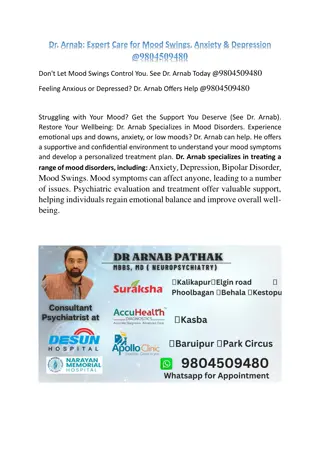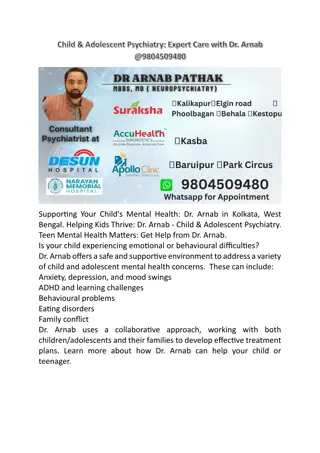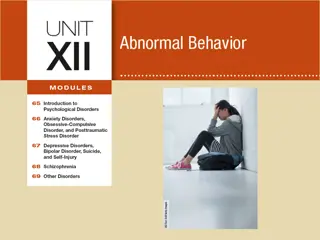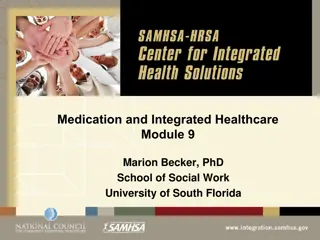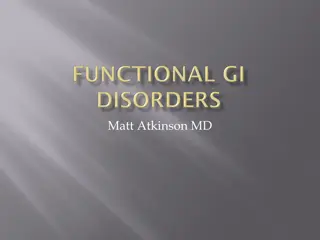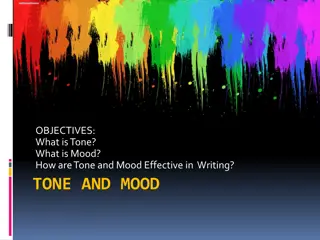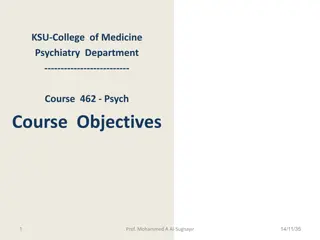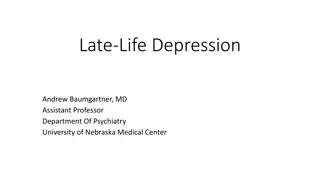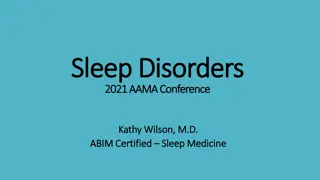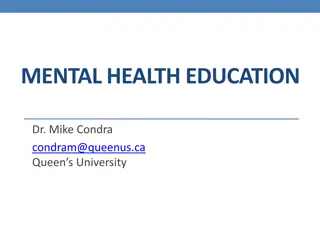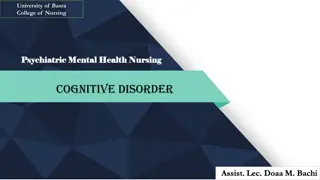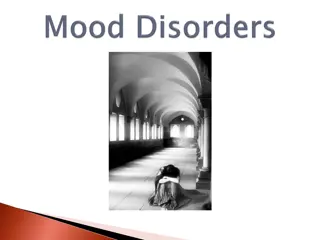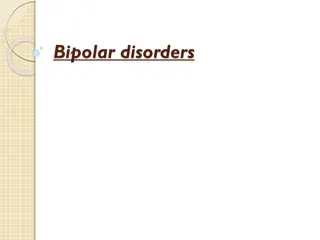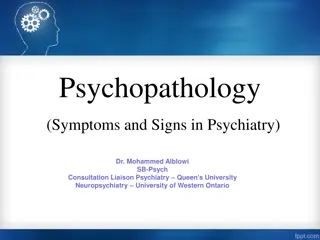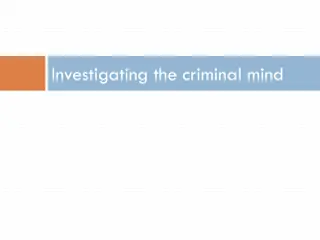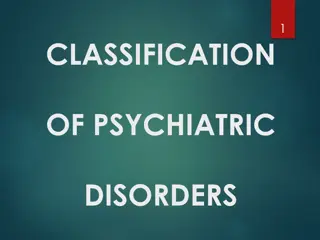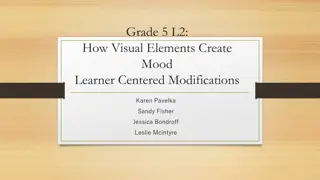Mood Disorders and Assessment in Psychiatry
Mood disorders, such as Major Depressive Disorder and Bipolar Disorder, can significantly impact a person's life. They are characterized by disruptions to functional status and relationships. Assessing these disorders involves examining psychiatric history, medical background, and lab assessments like CBC and metabolic panels. Additionally, exploring case formulation with the 5 Ps can provide valuable insights into the individual's situation.
Uploaded on Jul 16, 2024 | 0 Views
Download Presentation

Please find below an Image/Link to download the presentation.
The content on the website is provided AS IS for your information and personal use only. It may not be sold, licensed, or shared on other websites without obtaining consent from the author.If you encounter any issues during the download, it is possible that the publisher has removed the file from their server.
You are allowed to download the files provided on this website for personal or commercial use, subject to the condition that they are used lawfully. All files are the property of their respective owners.
The content on the website is provided AS IS for your information and personal use only. It may not be sold, licensed, or shared on other websites without obtaining consent from the author.
E N D
Presentation Transcript
MOOD DISORDERS SANGEETA SRIVASTAVA AWASTHI, MD DIRECTOR OF ONCO-PSYCHIATRY TEXAS TECH UNIVERSITY HEALTH SCIENCE CENTER
WHAT IS MOOD? WHAT IS AFFECT? MOOD: How do you feel? A pervasive and sustained emotion that colors a person s perception. Can be described by the person as: depressed, sad, empty, irritable, happy, angry AFFECT: What does the clinician observe? Can be described as appropriate, inappropriate, mood-congruent, mood-incongruent, labile, flat, blunted, silly
WHAT IS A MOOD DISORDER? Symptoms cause a disruption to functional status, relationships, education or employment Major Depressive Disorder Bipolar Disorder (BPD) Types I and II Mania Hypomania Common- 35% of the population
5 PS OF CASE FORMULATION Presenting problem(s) Predisposing factors which make the person vulnerable Precipitating factors which triggered the problem Perpetuating factors which keep a problem going Protective factors
ASSESSMENT Psychiatric History History of depressive symptoms History of manic, hypomanic symptoms Comorbidities that would impact response: substance use, anxiety disorders, personality disorders Safety: suicide/homicide risk, ability to care for dependents Medical History Current medications, drugs of abuse Medical illnesses, recent work-ups and lab results Psychosocial History Modifiable stressors: domestic violence, lack of support system Triggers: divorce, termination, death of loved one..
LAB ASSESSMENTS CBC with Differential Complete Metabolic Panel Magnesium Thyroid functions: TSH, free T4, T3 Vitamin B12 and folate Vitamin D Urine toxicology Consider RPR and HIV Consider Homocysteine Consider MTHFR mutation
AS NEEDED ASSESSMENTS MRI: If any neurologic or cognitive changes Urinalysis: In elderly, 20% admitted to the hospital have UTI Pregnancy test: In any woman of childbearing age EKG: If planning to use TCA, Lithium or Antipsychotic Sleep Study: Sleep apnea
EKG Antipsychotics: Can increase the QTc interval and have potential for Torsades de Pointes Lithium: Risk of Supraventricular Arrhythmias (Sick Sinus Syndrome and Sinoatrial Block) and rarely Ventricular Arrhythmias TCAs: Increase PR, QRS, QTc intervals and have potential for Complete AV Block and Sudden Death
DEPRESSIVE DISORDERS Major depressive disorder, single episode or recurrent Persistent depressive disorder Disruptive mood dysregulation disorder Premenstrual dysphoric disorder Substance/medication-induced depressive disorder Depressive disorder due to another medical condition Other specified depressive disorder Unspecified depressive disorder
MAJOR DEPRESSIVE DISORDER Lifetime prevalence 17% Female:male ratio 2:1 25% risk to first degree relatives 50% of people will have a subsequent episode Risk of recurrence increases with age & number of episodes 50% recover within 6 months 15% lifetime suicide risk Anxiety disorders common 10% develop psychotic features
SUICIDE IN DEPRESSION 10%-15% of all patients hospitalized for depression commit suicide Factors suggesting increased risk for suicide Being divorced or living alone History of alcohol or drug abuse Being older than 40 History of prior suicide attempt Suicidal ideation with a plan Family history of suicide
A 30-year-old man presents to your office complaining of being down the last month. He has been suffering from difficulty falling and staying asleep, severe fatigue, guilt, poor appetite, and thoughts of wanting to take his life. He does not ever recall feeling this bad. He has stopped talking with his friend and has no interest in doing anything. You believe he is suffering from a major depressive disorder. In order to diagnose this, which symptom must be present? A. Decreased appetite B. Fatigue C. Insomnia D. Loss of interest (anhedonia)
DEPRESSIVE SYMPTOMS- SIG E CAPS Sleep disturbance Interest Guilt Energy Concentration Appetite Psychomotor Activity Suicidal Ideation
MAJOR DEPRESSIVE EPISODE CRITERIA 5 or more symptoms present nearly every day during the same 2-week period (representing a change from previous functioning) where at least one symptom is either depressed mood or loss of interest or pleasure Depressed mood most of the day, nearly daily Diminished interest or pleasure Significant weight loss (5% of body weight in 1 month) Insomnia/Hypersomnia Psychomotor agitation/retardation Fatigue Feelings of worthlessness Difficulty concentrating Thoughts of death, or suicidal thoughts or behaviors
MAJOR DEPRESSION PATHOGENESIS Family Study: MDD found to be 2-4 times more frequent in relatives of those with MDD. Twin Study: MDD is 50 % in monozygotic twins Vs. 20 % in dizygotic . Genetic Monoamine: Meds that deplete monoamines worsen the depression (Reserpine). Serotonin: Low P 11 intracellular protein that recruit 5HT 1 A receptors to neuronal surface. P11 is low in depression. All Ads, ECT increase P11. Low CFS serotonin in Patient after suicide. Biogenic Amine Hypothesis Biological Hypothesis of MDD Pathogenesis Sleep Increase in Nocturnal arousal & awakening, Reduced REM latency, Increase REM density Dysregulation Hypothalamic-Pituitary- adrenal/thyroid Axis dysrequlation: Hypersecretion of cortisol is present, DST; NON-suppression of cortisol seen in 50% in Pts. with melancholia. 5%-10% of depressed patient have Abn. thyroid function. Blunted response to TRH challenge Hormonal Abnormalities MRI: Neurodegenerative disorders increase risks for depression; more hyperintensities in subcortical regions and reduced in hippocampus. PET scan show decreased prefrontal metabolism Brain images
MAJOR DEPRESSION COURSE OF ILLNESS Risk of relapse after one episode is 50%, 80% after third episode 20% will continue to feel depressed after 2 years 30% will remit within 6-24 months Average length of episode is 4-5 months, 6 months after episode 50% will have full recovery
PERSISTENT DEPRESSIVE DISORDER Chronic and persistent disturbance in mood present for at least 2 years Presence of at least 2/6 symptoms continuously for 2 years Poor appetite or overeating Insomnia or hypersomnia Low energy or fatigue Low self-esteem Poor concentration or difficulty making decisions Feelings of hopelessness
A 34 year old man complains of a depressed mood for as long as I can remember. His sleep is poor, interest is fair, denies guilt, energy level is decent , concentration is fair, and appetite fluctuates, though he has not had any weight loss. He has trouble making decisions and his self-esteem is low. He denies suicidal ideation and any medical problems or drug use. Which treatments may be helpful? A. Lithium B. SSRIs C. SNRIs D. Cognitive behavioral therapy
DISRUPTIVE MOOD DYSREGULATION DISORDER
DISRUPTIVE MOOD DYSREGULATION DISORDER Chronic, severe and persistent irritability, severe recurrent temper tantrums Symptoms present for at least 12 months Symptoms begin before age 10, occur in at least 2 settings Diagnosis is not made before age 6 or after age 18 Cannot be comorbid with oppositional-defiant, bipolar or intermittent explosive disorders
A 12 year old boy begins to have a new episodes of temper outbursts that are out of proportion to the situation. Which of the following is not a diagnostic possibility for this patient? A. Bipolar disorder B. Disruptive mood dysregulation disorder C. Oppositional defiant disorder D. Conduct disorder E. Attention deficit/hyperactivity disorder
PREMENSTRUAL DYSPHORIC DISORDER (PMDD)
PREMENSTRUAL DYSPHORIC DISORDER (PMDD) At least 5 symptoms total must be present in final week before menses, improve within a few days of menses, and become minimal after menses (in the majority of menstrual cycles) Associated symptoms: Mood symptoms: Decreased interest Marked affective lability, mood swings, sudden tearfulness, increased sensitivity to rejection Concentration difficulty Insomnia or hypersomnia Marked irritability, anger, increased conflicts Fatigue Marked depressed mood, hopelessness, self- deprecating thoughts Easily overwhelmed Change in appetite Marked anxiety, tension Weight gain, bloating, muscle/joint pain, breast tenderness or swelling
RISK FACTORS FOR PMDD Occurs in 3-8% of menstruating women Fluctuations in estrogen and progesterone leads to serotonin deficiency History of depressive or anxiety disorder, especially peripartum depression Increasing age Lack of exercise Stress Low Calcium, Magnesium, Vitamin B6 Family history of PMDD
TREATMENT FOR PMDD Non-Pharmacologic CBT Exercise Light Therapy Carbohydrates (chocolate!) Pharmacologic SSRIs Anxiolytics Oral Contraceptive Supplements: Multivitamin, Calcium, Magnesium, Vitamin B6 NSAIDs, Diuretics
A 23 year old graduate student presents with severe abdominal cramps, bloating and difficulty concentrating. She reports her studies have been suffering because of these symptoms. She recalls the same troublesome symptoms occurred last month around the same time, but resolved on their own after her period started. Her boyfriend states, she has been so mean to me the last few days! It s like anything I do or say sets her off. She does not report any other medical problems. Which of the following is the first line treatment for these symptoms? A. Lithium B. Spironolactone C. Fluoxetine D. Maprotiline
PERI-PARTUM & POST-PARTUM DEPRESSIVE DISORDERS
DEPRESSION WITH PERIPARTUM ONSET Occurring during pregnancy or within 4 weeks following delivery Prevalence: 5% of pregnancies (half start during pregnancy) Anxiety and panic symptoms commonly comorbid Observe for psychosis, bipolar conversion or infanticide risk Differentiate from post-partum or baby blues Very common, usually self- limited Risk factors for Peripartum Depression Previous psychiatric illness Family history Limited social support Negative life events Low socioeconomic status Conflict with baby s father Infant illness Baby Blues
Postpartum Disorders Postpartum blues or Baby Blue Postpartum Depression Postpartum Psychosis Which Number Child Any Usually 2nd Usually 1st Onset Begins after birth and lasts up to 2 weeks Begins within 1 month of birth and symptoms may continue Begins within 1 month of birth and symptoms may continue Mother cares about the baby Yes May have thoughts about hurting the baby May have thoughts about hurting the baby Symptoms Mild depression Severe depression Severe depression and psychotic symptoms Treatment Self-limited; no treatment necessary Antidepressant Antidepressant and mood stabilizers or antipsychotics
SUBSTANCE/MEDICATION INDUCED DEPRESSIVE DISORDER
SUBSTANCE-INDUCED DEPRESSIVE DISORDER Alcohol Phencyclidine Other Hallucinogens Inhalant Opioid Sedative, Hypnotic, Anxiolytic Amphetamine or other Stimulant Cocaine Other or unknown substance
A 16 year old girl comes in to the ER at the insistence of her parents with a chief complaint of suicidal ideation with a plan of taking an overdose of medications. She states that for the past week she has not felt life is worth living, that her mood is sad, she has no energy, no motivation to do things that she normally used to enjoy. Prior to 1 week ago, she had none of these symptoms. The patient states he has been sleeping 12-14 hours/day for the past week and eating everything in sight. She says he has never been diagnosed with major depression or been seen by a psychiatrist. She is not aware of any medical problems. The patient states that up until 9 days ago she used cocaine on a daily basis for a month, but then stopped it when school started. On mental status exam, the patient appears alert and oriented x 3. Her speech is normal, but her mood is depressed , and her affect is constricted and dysphoric. She denies having hallucinations or delusions but has suicidal ideation with a specific intent and plan. She denies having homicidal ideation. What is the most likely diagnosis? And what would be the course of action? A. Major depressive disorder B. Substance induced mood disorder C. Cyclothymia D. Bipolar disorder
SECONDARY DEPRESSION: MEDICAL ETIOLOGIES Neoplasms Brain tumors Pancreatic cancer Paraneoplastic syndromes Immune Disorders AIDS Systemic Lupus Erythematosus Infectious Diseases Neurosyphilis AIDS Cardiac Post-MI Endocrine Thyroid Disease Cushing s Syndrome Neurologic Multiple Sclerosis Epilepsy Parkinson s Disease Huntington s Disease Alzheimer s Disease Traumatic Brain Injury Stroke Obstructive Sleep Apnea Anemia
MEDICATIONS ASSOCIATED WITH DEPRESSION Clonidine Acyclovir Metoclopramide Corticosteroids Anabolic Steroids Metronidazole Digitalis ACE Inhibitors NSAIDS Disulfiram Anticonvulsants Opioids Estrogen Baclofen Pergolide Guanethidine Barbiturates Reserpine H2 Receptor Blockers Benzodiazepines Sulfonamides Interferon A B-Blockers Thiazide Diuretics Interleukin-2 Bromocriptine Topiramate Isotretinoin Calcium Channel Blockers Vinblastine Levodopa Vincristine Methyldopa Ciprofloxacin
WHICH ANTIDEPRESSANT TO USE? All antidepressant medications are equally effective but differ in side-effect profiles. Medications usually take 4-6 weeks to fully work. Look for prior history, family history or desired side effects
PHARMACOTHERAPY FOR DEPRESSION Selective serotonin reuptake inhibitors (SSRIs) Escitalopram, Citalopram, Fluoxetine, Paroxetine, Sertraline Serotonin-norepinephrine reuptake inhibitors (SNRIs) Venlafaxine and Duloxetine 2-adrenergic receptor antagonist Mirtazapine Dopamine-norepinephrine reuptake inhibitor Bupropion (do not use in anorexia or in seizure disorder)
DOSES OF ANTIDEPRESSANTS SNRIs Venlafaxine: 37.5 mg-225 mg qd Duloxetine: 60 mg-120 mg qd Desvenlafaxine: 50 mg qd Mirtazapine: 15 mg-45 mg qhs Buproprion: 150 mg-300 mg Vortioxetine: 5 mg-20 mg qd SSRIs Escitalopram: 10-30 mg qd Citalopram: 20-40 mg qd Fluoxetine: 20-80 mg qd Paroxetine: 20-50 mg qd Setraline: 50 mg-200 mg qd Vilazodone: 20 mg-40mg qd
ANTIDEPRESSANT PHARMACOLOGY Duloxetine: HTN, Elevated LFTs, Palpitations, N/V, Oropharyngeal pain, SIADH, Suicidality, Urinary retention, Syncope, Hypertensive Crisis, Arrhythmias, Seizures Escitalopram: Headache, N/V, Decreased libido, Suicidality, QT prolongation Citalopram: Decreased Libido, SIADH, QT prolongation, Suicidality Desvenlafaxine: HTN, SIADH, N/V, Decreased libido (men), Seizures, Suicidality Fluoxetine: Headache, Tremor, SIADH, QT prolongation, Seizures, Altered platelet function Mirtazapine: Agranulocytosis, Orthostatic hypotension, Akathisa, Rhabdomyolysis, Torsades de Pointes, Elevated LFTs, Tremor Paroxetine: Palpitations, Abdominal pain, SIADH, Suicidality, Seizures Sertraline: N/V, Sexual dysfunction, SIADH, Seizures, Suicidality Buproprion: Seizures, MI, HTN, Hepatotoxicity, Arrhythmias, Narrow angle glaucoma, Tinnitus, Anorexia, Abdominal pain, Blurred vision, Chest pain, Insomnia Vilazodone: N/V, Sexual dysfunction, Arthralgia, Weight gain, SIADH, Suicidality Vortioxetine: SIADH, Suicidality, N/V, Sexual dysfunction, Pruritis, Abnormal dreams, Angioedema, Abnormal bleeding/Altered platelet function, Narrow angle glaucoma Venlafaxine: HTN, Palpitations, Flu syndrome, N/V, Headache, Elevated cholesterol, SIADH, Interstitial lung disease, Suicidality, Pancreatitis
A 36-year-old married man with a past history of a major depressive episode is brought into the emergency room by the police after stopping traffic on the highway proclaiming that he is the Messiah. His wife is contacted who states that he has been walking throughout the house all night for the last 7 nights, talking nonstop, and starting many home repair projects that remain unfinished. She confirms that he is taking sertraline for his depression and propranolol for high blood pressure. His blood alcohol level is less than 10, and his urine toxicology screen is negative. What is his likely diagnosis?
PHARMACOTHERAPY: ADJUNCT MEDICATIONS Atypical Antipsychotics (second-generation) Olanzapine, Quetiapine, Risperidone, Aripiprazole, Ziprasidone Thyroid Hormone: T3, T4 Lithium L-Methyl Folate (Deplin) Stimulants (Adderall)
DOSES OF ATYPICAL ANTIPSYCHOTICS Olanzapine: 2.5 mg-20 mg qd Quetiapine: 12.5 mg-400 mg qd Risperidone: 0.25 mg-4 mg qd Aripiprazole: 2mg-30 mg qd Ziprasidone: 40-80 mg bid
SEROTONIN SYNDROME Autonomic instability, hyperthermia, hyperreflexia (including myoclonus), and seizures Coma or death may result Increased risk if one multiple medications known to increase serotonin levels
A patient returns to your office for a medication check. Sertraline was started 4 months ago. The dose has been increased twice, and the patient has been taking 200 mg for 2 months. She feels the medication has provided some, but not total, relief from her symptoms, and she has tolerated the medication well. You augment with 40 mg of duloxetine. The next morning the patient calls to report she is not feeling well. She has a headache, chills, her heart is racing, and her temperature is 102 F (38.9 C). What instructions should you give your patient? A. Have her come to your office this afternoon when you have an opening B. Nothing. It is probably a virus. C. Tell the patient to go directly to the emergency department D. Have her call her primary care physician
MEDICATIONS THAT CAN INCREASE SEROTONIN Antidepressants SSRIs, SNRIs Bupropion TCAs, MAOIs Migraine Medications Triptans Tegretol, Depakote Herbal Supplements St John s Wort, Ginseng, Nutmeg Cold and Cough Medications Dextromethorphan, Delsym Mucinex Illegal Drugs LSD, Ecstasy Cocaine, Amphetamines Lithium Anti-Nausea Medications Zofran, Reglan, Droperidol Antibiotic- Linezolid Antiretroviral- Ritonavir Pain Medications Meperidine Tramadol Fentanyl, Codeine, Oxycodone
TREATMENT FOR SEROTONIN SYNDROME Mild Stop serotonergic medications Moderate-Severe Muscle Relaxants: Benzodiazepines Serotonin-production Blocking Agents: Cyproheptadine Oxygen and IV Fluids: Treat dehydration and fever Control Heart Rate & Blood Pressure: Esmolol, Nitroprusside, Phenylephrine, Epinephrine Ventilator Medications to paralyze muscles



